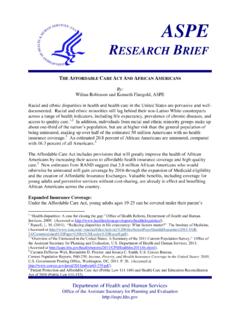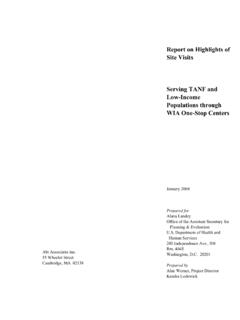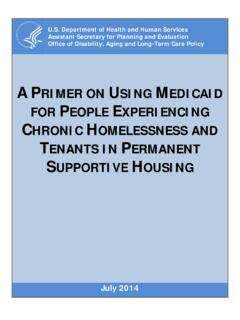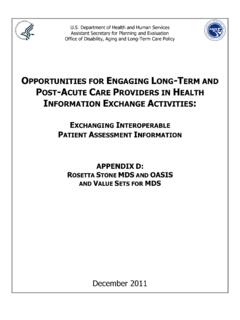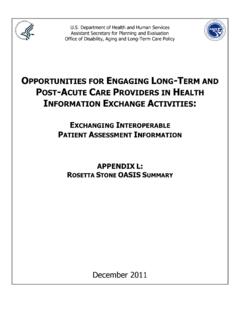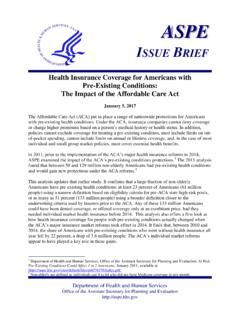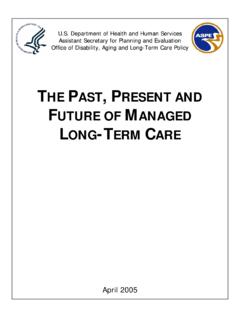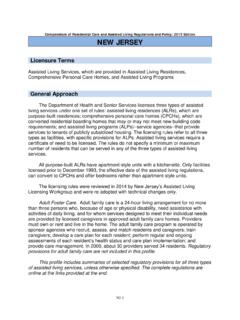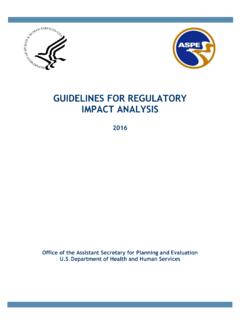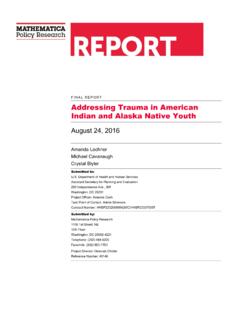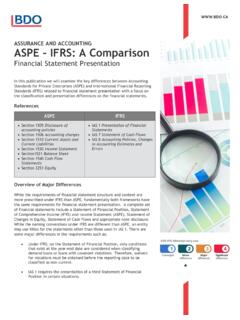Transcription of HP-2021-12 Estimates of Uninsured Adults Newly ... - ASPE
1 May 2021 DATA POINT 1 HP-2021-12 Estimates of Uninsured Adults Newly Eligible for Medicaid If Remaining Non-Expansion States Expand Approximately million Uninsured non-elderly Adults would be Newly eligible for Medicaid if non-expansion states were to expand eligibility for Adults to 138% of the Federal Poverty Level (FPL). D. Keith Branham, Christie Peters, and Benjamin D. Sommers KEY POINTS In the 13 states that have not expanded Medicaid (excluding Oklahoma, see Table 1 notes), we estimate that million Uninsured non-elderly Adults would be Newly eligible for Medicaid if all the states were to expand eligibility for Adults to 138% FPL. In the 13 states that have not expanded Medicaid, nearly million Uninsured non-elderly Adults with incomes below 100% FPL who are in what is sometimes called the coverage gap would become Newly eligible for Medicaid if their states were to expand.
2 Among Uninsured Black Adults in the 13 non-expansion states, expansion would increase the number who are Medicaid eligible almost fivefold, while the number among Uninsured Hispanic Adults would increase sixfold. OVERVIEW The tables below contain pre-pandemic Estimates of potential Medicaid eligibility among Uninsured , non-elderly Adults in states that have not expanded Medicaid coverage to Adults with incomes up to 138% of the Federal Poverty Level (FPL). Table 1 also includes Oklahoma, which plans to implement the Medicaid expansion in July 2021. Under the American Rescue Plan Act (ARP), Oklahoma will qualify to receive the financial incentives for expansion of Medicaid included in the Act. The Estimates are drawn from ASPE s microsimulation model the Transfer Income Model version 3 (TRIM3) which simulates major government tax, benefit, and health insurance programs in the METHODS These Estimates come from an analysis of the Census Bureau s Current Population Survey for calendar year 2018, using each state s rules for Medicaid eligibility as of 2021.
3 The Estimates are annual individuals ever eligible in the year by state (Table 1). We also include Estimates by demographic characteristics including age, income, race and ethnicity, and sex (Table 2). May 28, 2021 DATA POINT May 2021 DATA POINT 2 RESULTS In the 13 states that have not expanded Medicaid (excluding Oklahoma, see Table 1 notes), we estimate that million Uninsured non-elderly Adults would be Newly eligible for Medicaid if all 13 states were to expand eligibility for Adults to 138% FPL. This represents 34% of the Uninsured non-elderly adult population in these states. Texas contains the largest share of the Newly eligible with nearly million; Florida, Georgia, and North Carolina together contain another million. TABLE 1: Uninsured Non-elderly Adults (Ages 19-64)
4 Potentially Eligible for Medicaid Expansion, by State Total Uninsured Population, Ages 19-64 Medicaid Eligible Before Expansion Medicaid Eligible After Expansion Newly Eligible After Expansion Percent of Uninsured Population Newly Eligible Alabama 499,000 33,000 273,000 240,000 Florida 2,631,000 234,000 1,030,000 796,000 Georgia 1,371,000 130,000 575,000 445,000 Kansas 187,000 25,000 82,000 57,000 Mississippi 349,000 30,000 219,000 189,000 Missouri^ 383,000 40,000 244,000 204,000 North Carolina 916,000 80,000 408,000 328,000 Oklahoma* 532,000 53,000 244,000 190,000 South Carolina 389,000 51,000 188,000 136,000 South Dakota 62,000 7,000 30,000 23,000 Tennessee 465,000 43,000 222,000 179,000 Texas 4,228,000 217,000 1,595,000 1,378,000 Wisconsin# 297,000 81,000 112,000 31,000 Wyoming 55,000 4,000 28,000 24,000 Total 12,365,000 1,029,000 5,249,000 4,220,000 Total Excluding Oklahoma 11,832,000 975,000 5,005,000 4,030,000 Table Notes: The baseline data source for TRIM3 is the March 2019 (CY 2018) Current Population Survey, Annual Social and Economic Supplement (CPS ASEC) 1-year Estimates .
5 People are counted as Uninsured if they are not classified in the survey data as having any type of insurance coverage for any part of the year; also, Medicaid enrollment that was imputed by the Census Bureau is disregarded for individuals with incomes too high to qualify based on their state and characteristics. The model accounts for under-reporting of benefits in the survey and assesses adult eligibility using the modified adjusted gross income (MAGI) FPL standards in place in 2021, along with other eligibility policies related to Supplemental Security Income and medically needy programs in place in 2018. Undocumented immigrants imputed to be unauthorized are still included in the total Uninsured Estimates ; however, those imputed to be unauthorized are not classified as Medicaid-eligible in the analysis.
6 Numbers of people are shown rounded to the nearest thousand and numbers may not sum precisely due to rounding. Percentages are computed based on unrounded numbers. ^ Missouri voters passed a constitutional amendment in 2020 to expand Medicaid, but the state withdrew its State Plan Amendments related to expansion in May 2021 * Oklahoma will implement its Medicaid expansion beginning July 2021. # Wisconsin offers Medicaid eligibility to Adults with income up to 100% FPL, which is the reason for its lower relative percent of total population Newly eligible compared to other non-expansion states. May 2021 DATA POINT 3 We estimate that in the 13 states that have not expanded Medicaid eligibility for Adults to 138% FPL, nearly million Uninsured non-elderly Adults with incomes below 100% FPL would be Newly eligible for Medicaid if their states were to expand.
7 This group not currently eligible for Medicaid in their states, but with incomes too low to qualify for Marketplace advanced premium tax credits (APTCs) falls into what is sometimes called the coverage gap. This group represents percent of the Newly eligible population. The remainder of the Newly eligible population currently does qualify for Marketplace APTCs. The number of people eligible for Medicaid among Uninsured Black Adults in the 13 non-expansion states would increase almost fivefold, and it would increase sixfold among Uninsured Hispanic Adults . Younger Adults (ages 19-34) would experience greater gains in new eligibility ( million) than those ages 35-49 ( million) and 50-64 ( million). TABLE 2: Demographic Characteristics of Uninsured Non-Elderly Adults (Ages 19-64) Potentially Eligible for Medicaid Expansion Annual Eligibility Before Expansion After Expansion Newly Eligible After Expansion # % # % # % Total Eligible (14 states) 1,029,000 5,249,000 4,220,000 Total Eligible (13 states, excluding Oklahoma)* 975,000 5,005,000 4,030,000 13 States (Excluding Oklahoma)* Age: 19-34 435,000 2,350,000 1,915,000 35-49 357,000 1,444,000 1,087,000 50-64 183,000 1,210,000 1,027,000 Annual Income (FPL) Below 100% 758,000 3,017000 2,259,000 100-138% 69,000 1,125,000 1,057,000 Above 138%1 148,000 862,000 714,000 Race/ethnicity.
8 2 White, Non-Hispanic 445,000 2,133,000 1,688,000 Black, Non-Hispanic 263,000 1,242,000 980,000 Asian/PI, Non-Hispanic 19,000 120,000 101,000 AI/AN, Non-Hispanic 10,000 65,000 55,000 Other, Non-Hispanic 13,000 84,000 72,000 Hispanic3 226,000 1,361,000 1,135,000 Sex: Male 448,000 2,506,000 2,058,000 Female 527,000 2,499,000 1,971,000 Table Notes: 1) These persons are eligible for Medicaid at some point during the year based on having monthly MAGI below 138% FPL in at least one month. 2) Non-Hispanic persons were categorized as White, Black, Asian/Pacific Islander (PI), or American Indian/Alaskan Native (AI/AN) only if they reported a single race. 3) People who are Hispanic are shown in this row regardless of the race(s) they report.
9 * Oklahoma will implement its Medicaid expansion beginning July 2021. The state is excluded from the demographic distributions in the table. May 2021 DATA POINT 4 DEPARTMENT OF HEALTH AND HUMAN SERVICES Office of the Assistant Secretary for Planning and Evaluation 200 Independence Avenue SW, Mailstop 447D Washington, 20201 For more ASPE briefs and other publications, visit: ABOUT THE AUTHORS D. Keith Branham is a Senior Research Analyst for the Office of Health Policy in ASPE. Christie Peters is the Director of the Division of Health Care Access and Coverage for the Office of Health Policy in ASPE. Benjamin D. Sommers is the Deputy Assistant Secretary for the Office of Health Policy in ASPE. SUGGESTED CITATION Branham DK, Peters C, and Sommers BD. Estimates of Uninsured Adults Newly Eligible for Medicaid If Remaining Non-Expansion States Expand (Data Point No.)
10 HP-2021-12 ). Washington, DC: Office of the Assistant Secretary for Planning and Evaluation, Department of Health and Human Services. May 28, 2021. COPYRIGHT INFORMATION All material appearing in this report is in the public domain and may be reproduced or copied without permission; citation as to source, however, is appreciated. DISCLOSURE This communication was printed, published, or produced and disseminated at taxpayer expense. _____ Subscribe to ASPE mailing list to receive email updates on new publications: For general questions or general information about ASPE: HP-2021-12
